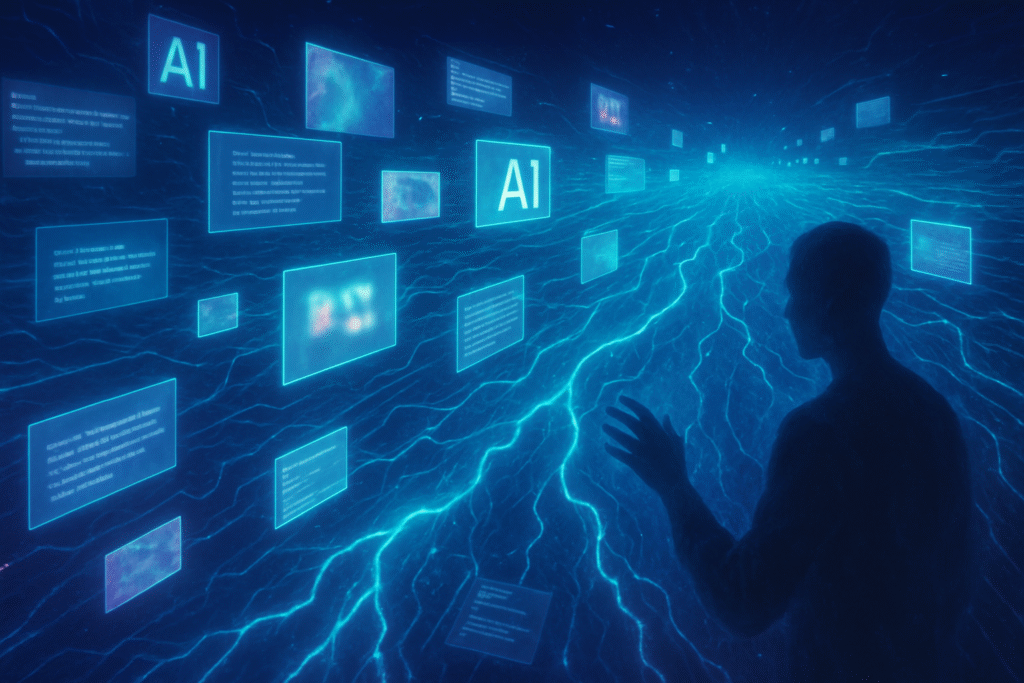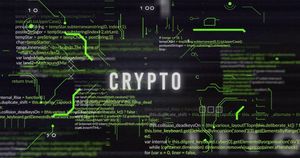
The digital world has crossed a profound threshold: a recent groundbreaking study reveals that more than half of all written articles online are now generated by artificial intelligence. This seismic shift, evidenced by research from prominent SEO firm Graphite, signals an unprecedented era where machine-generated content not only coexists with but dominates human output, raising critical questions about authenticity, trust, and the very fabric of our digital ecosystems. The implications are immediate and far-reaching, fundamentally altering how we consume information, how content is created, and the strategic landscape for AI companies and tech giants alike.
This dramatic acceleration in AI content generation, alongside expert predictions suggesting an even broader saturation across all online media, marks a pivotal moment in the evolution of the internet. It underscores the rapid maturation and pervasive integration of generative AI technologies, moving from experimental tools to indispensable engines of content production. As the digital realm becomes increasingly infused with algorithmic creations, the imperative for transparency, robust detection mechanisms, and a redefinition of value in human-generated content has never been more urgent.
The AI Content Deluge: A Technical Deep Dive
The scale of AI's ascendance in content creation is starkly illustrated by Graphite's study, conducted between November 2024 and May 2025. Their analysis of over 65,000 English-language web articles published since January 2020 revealed that AI-generated content surpassed human-authored articles in November 2024. By May 2025, a staggering 52% of all written content online was found to be AI-created. This represents a significant leap from the 39% observed in the 12 months following the launch of OpenAI's (NASDAQ: MSFT) ChatGPT in November 2022, though the growth rate has reportedly plateaued since May 2024.
Graphite's methodology involved using an AI detector named "Surfer" to classify content, deeming an article AI-generated if more than 50% of its text was identified as machine-produced. The data was sourced from Common Crawl, an extensive open-source dataset of billions of webpages. This empirical evidence is further bolstered by broader industry predictions; AI expert Nina Schick, for instance, projected in January 2025 that 90% of all online content, encompassing various media formats, would be AI-generated by the close of 2025. This prediction highlights the comprehensive integration of AI beyond just text, extending to images, audio, and video.
This rapid proliferation differs fundamentally from previous content automation efforts. Early content generation tools were often template-based, producing rigid, formulaic text. Modern large language models (LLMs) like those underpinning the current surge are capable of generating highly nuanced, contextually relevant, and stylistically diverse content that can be indistinguishable from human writing to the untrained eye. Initial reactions from the AI research community have been a mix of awe at the technological progress and growing concern over the societal implications, particularly regarding misinformation and the erosion of trust in online information.
Corporate Chessboard: Navigating the AI Content Revolution
The dramatic rise of AI-generated content has profound implications for AI companies, tech giants, and startups, creating both immense opportunities and significant competitive pressures. Companies at the forefront of generative AI development, such as OpenAI (NASDAQ: MSFT), Google (NASDAQ: GOOGL), and Anthropic, stand to benefit immensely as their models become the de facto engines for content production across industries. Their continued innovation in model capabilities, efficiency, and multimodal generation will dictate their market dominance.
Conversely, the proliferation of AI-generated content presents a challenge to traditional content farms and platforms that rely heavily on human writers. The cost-effectiveness and speed of AI mean that businesses can scale content production at an unprecedented rate, potentially displacing human labor in routine content creation tasks. This disruption is not limited to text; AI tools are also impacting graphic design, video editing, and audio production. Companies offering AI detection and content provenance solutions, like those contributing to the Content Authenticity Initiative (CAI) and the Coalition for Content Provenance and Authenticity (C2PA), are also poised for significant growth as the demand for verifiable content sources escalates.
Tech giants like Google (NASDAQ: GOOGL) are in a complex position. While they invest heavily in AI, their core business relies on the integrity and discoverability of online information. Google's demonstrated effectiveness in detecting "AI slop" – with only 14% of top-ranking search results being AI-generated – indicates a strategic effort to maintain quality and relevance in search. This suggests that while AI produces volume, search performance may still favor high-quality, human-centric content, leading to a potential plateau in the growth of low-quality AI content as practitioners realize its limited SEO value. This dynamic creates a competitive advantage for companies that can effectively blend AI efficiency with human oversight and quality control.
The Wider Significance: Authenticity, Ecosystems, and Trust
The fact that over half of online content is now AI-generated represents a watershed moment with far-reaching societal implications. At its core, this trend ignites a profound content authenticity crisis. As the line between human and machine blurs, discerning genuine, original thought from algorithmically synthesized information becomes increasingly difficult for the average user. This erosion of trust in online media is particularly concerning given the rise of misinformation and deepfakes, where AI-generated content can be weaponized to spread false narratives or manipulate public opinion.
This shift fundamentally alters digital ecosystems. The economics of the web are evolving as AI-driven tools increasingly replace traditional search, pushing content discovery towards AI-generated summaries and answers rather than direct traffic to original sources. This could diminish the visibility and revenue streams for human creators and traditional publishers. The demand for transparency and verifiable content provenance has become paramount. Initiatives like the Adobe-led CAI and the C2PA are crucial in this new landscape, aiming to embed immutable metadata into digital content, providing a digital fingerprint that confirms its origin and any subsequent modifications.
Comparatively, this milestone echoes previous AI breakthroughs that reshaped public perception and interaction with technology. Just as the widespread adoption of social media altered communication, and the advent of deepfakes highlighted the vulnerabilities of digital media, the current AI content deluge marks a new frontier. It underscores the urgent need for robust regulatory frameworks. The EU AI Act, for example, has already introduced transparency requirements for deepfakes and synthetic content, and other jurisdictions are considering similar measures, including fines for unlabeled AI-generated media. These regulations are vital steps towards fostering responsible AI deployment and safeguarding digital integrity.
The Horizon: Future Developments and Emerging Challenges
Looking ahead, the trajectory of AI-generated content suggests several key developments. We can expect continuous advancements in the sophistication and capabilities of generative AI models, leading to even more nuanced, creative, and multimodal content generation. This will likely include AI systems capable of generating entire narratives, complex interactive experiences, and personalized content at scale. The current plateau in AI-generated ranking content suggests a refinement phase, where the focus shifts from sheer volume to quality and strategic deployment.
Potential applications on the horizon are vast, ranging from hyper-personalized education materials and dynamic advertising campaigns to AI-assisted journalism and automated customer service content. AI could become an indispensable partner for human creativity, handling mundane tasks and generating initial drafts, freeing up human creators to focus on higher-order strategic and creative endeavors. We may see the emergence of "AI co-authorship" as a standard practice, where humans guide and refine AI outputs.
However, significant challenges remain. The arms race between AI content generation and AI detection will intensify, necessitating more advanced provenance tools and digital watermarking techniques. Ethical considerations surrounding intellectual property, bias in AI-generated content, and the potential for job displacement will require ongoing dialogue and policy intervention. Experts predict a future where content authenticity becomes a premium commodity, driving a greater appreciation for human-generated content that offers unique perspectives, emotional depth, and verifiable originality. The balance between AI efficiency and human creativity will be a defining characteristic of the coming years.
Wrapping Up: A New Era of Digital Authenticity
The revelation that over half of online content is now AI-generated is more than a statistic; it's a defining moment in AI history, fundamentally altering our relationship with digital information. This development underscores the rapid maturation of generative AI, transforming it from a nascent technology into a dominant force shaping our digital reality. The immediate significance lies in the urgent need to address content authenticity, foster transparency, and adapt digital ecosystems to this new paradigm.
The long-term impact will likely see a bifurcation of online content: a vast ocean of AI-generated, utility-driven information, and a highly valued, curated stream of human-authored content prized for its originality, perspective, and trustworthiness. The coming weeks and months will be critical in observing how search engines, social media platforms, and regulatory bodies respond to this content deluge. We will also witness the accelerated development of content provenance technologies and a growing public demand for clear labeling and verifiable sources. The future of online content is not just about what is created, but who (or what) creates it, and how we can confidently distinguish between the two.
This content is intended for informational purposes only and represents analysis of current AI developments.
TokenRing AI delivers enterprise-grade solutions for multi-agent AI workflow orchestration, AI-powered development tools, and seamless remote collaboration platforms.
For more information, visit https://www.tokenring.ai/.





